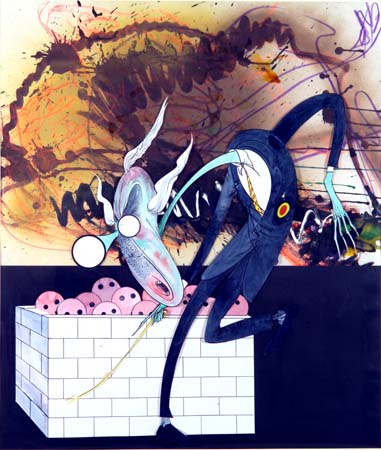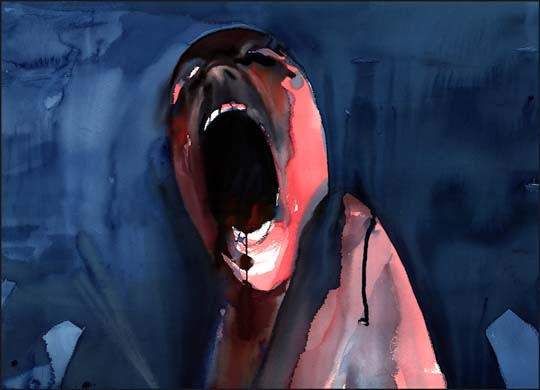Well, when I was puzzling out James Rado's various changes to the stage script over the years and which ones to use in another entry, I sort of got an idea. If you've been reading the blog regularly, you'll recall that I noted in the aforementioned entry that Galt MacDermot had gradually added music (and an actual song) over the years to segments of Claude's trip that previously just had underscoring, creating a mini-rock opera within the show (or a "movie in Claude's mind," to borrow the language of another musical set during the Vietnam War). I gave the hallucination a one-line description which went a little like this: "Claude has a bad head trip via shades of The Wall." And thus was born the germ of my idea, how to show Claude's trip on film!
In 2002, a parody of Seventies kung-flu flix from China called Kung Pow: Enter the Fist was released. It was hilarious, especially to a boy of 12 such as I was at the time, but that's not the point I'm making. In watching the video release, I saw the trailer for (what would pass in my definition as) an art house film called Waking Life. It's a very trippy movie at its core, very philosophical; the plot can best be described as a guy having a dream and wandering through it, and during that dream he meets a bunch of people and discusses various meanings and purposes to the universe. I looked it up because I liked the animation style in the trailer; it was something I couldn't identify. Very realistic, but it was clear that this was a heightened view; clearly based on realistic images, but with something animated added to it. I learned later thanks to the magic of Wikipedia that this was called a "digital enhancement" technique, and that rotoscoping was used in the making of the film. Basically, the entire film was shot on digital video (thereby making it look to a layman and non-film junkie like a live broadcast as opposed to film), and then a team of artists drew stylized lines and colors over each frame using computers. It looked somewhat like the pics that follow.
As you can see, the film looks like a literal representation of someone's head trip as a result of this revolutionary technique -- heightened views of reality. This was my initial influence for how to show Claude's trip on film, but then I remembered two things: one, it turns into the biggest "bum trip" in human history, a decent (if sometimes wacky) record of man's inhumanity to man over the course of time, and two, we still have to contend with the fact that this is a part of Claude's movie, i.e., we have to somehow remind the audience that what's happening in his head is somehow a part of his movie as well. The second one was the easier fix (a la stories of John Lennon frantically scribbling illustrations during his first acid trip that this rabid Beatles fan learned generations ago, I picture Claude being inspired to draw storyboards of what he sees while everyone else is tripping out, his way of trying to deal with what he's seeing), but it was the first one that presented a problem. The Waking Life technique evoked a dream-like quality (which of course would be filtered through conventional 2D animation in the psychedelic style of Peter Max and Yellow Submarine), but for the worst portions of the trip, we need a real psychedelicized nightmare. And that's where The Wall came in.
The Wall, as any Pink Floyd fan worth their salt will recall, was a really really fucked-up movie (albeit with some fantastic music, and a lot of insight into Roger Waters' inner self that no one ever needed). But what gave the movie its sense of "fucked-up" the most was the illustrations by artist Gerald Scarfe. His animation for the film was amazing, and seemed to me to be an exhaustive response to all the "flower power" cartoon jiggery-pokery that had come in the years before it. This was animation at its most dark and disturbing, as exemplified below.
Truly haunting imagery there. Bleak. Dark. Depressing. It's not the tone the whole trip should take, but for sequences like "The War," "Children's Games," and "Three-Five-Zero-Zero," filtering the whole Waking Life idea through stuff like this would have the best effect, and convey what Claude is learning and how he is being made to feel.
So to re-cap: Claude's trip is Waking Life/Peter Max/Yellow Submarine as filtered through the lens of Gerald Scarfe's work in The Wall.











No comments:
Post a Comment